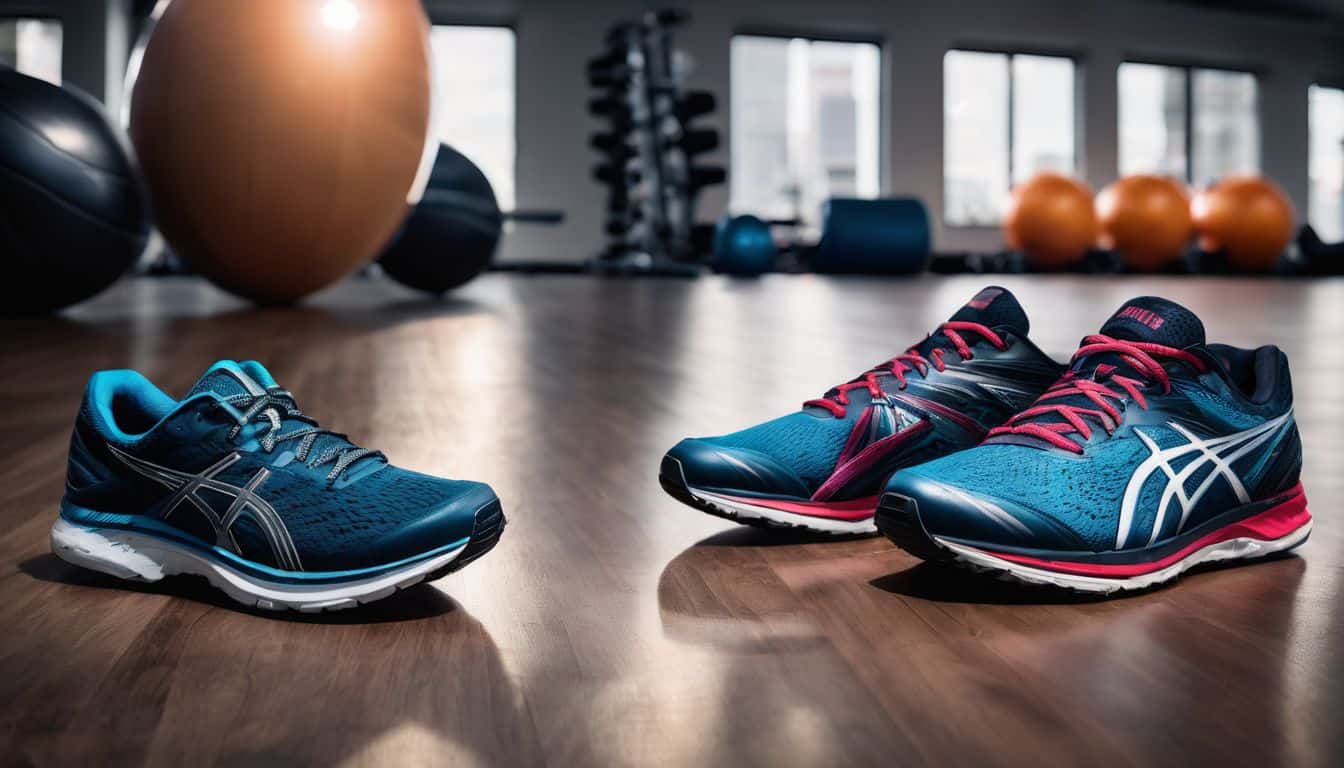Just like you, fellow fitness buffs, I once pondered over whether it was okay to pound the pavement in my usual gym or training shoes. It was a question that kept me up at night and eventually led me on a quest for knowledge – digging through research and learning from personal experience about the fundamental differences between running shoes and training shoes.
Each type has been meticulously designed with specific activities in mind. In this enlightening article, we’re going to peel back these layers of design, explore potential hazards of hitting the trail in trainers instead of properly crafted running shoes, and soak up wisdom from industry experts.
So grab your water bottle and favorite pair of socks – we’re heading out on an educational odyssey towards finding the perfect shoe for each workout!
Key Takeaways
- Training shoes and running shoes have distinct differences in flexibility, heel drop, stack height, and upper materials.
- Running in training shoes can increase the risk of injuries and negatively impact performance due to lack of proper cushioning and support for running.
- Experts recommend using training shoes for high – intensity gym classes, outdoor boot camps, weight lifting, and strength training activities.
Differences Between Training Shoes and Running Shoes
Training shoes and running shoes differ in terms of flexibility, heel drop, stack height, and upper materials.
Flexibility of the sole
Training shoes have a sole that bends and twists well. It helps me move in many ways. The soft middle part of the shoe lets my foot move as it should. This is great for high-energy training because I feel more grounded.
On the other hand, running shoes also have a bendy sole but they give better touch sense and help me run faster. But, running shoes may not offer as much comfort or pads like training shoes do while running.
Heel drop
The heel drop of a shoe is key to how it feels on your foot. It’s the height difference from the heel to the toe. Running shoes often have a high heel drop. This gives more cushion and support for your feet.
But training shoes have less of a heel drop. This makes them feel closer to the ground. Low-drop shoes can lessen hurt risk for people who don’t run much. The load point on hips, knees, ankles, and lower legs changes with different drops in running shoes.
That hike from heel to toe sets where your foot will hit when you run or walk!
Stack height
In training shoes, stack height counts a lot. It’s the space from your feet to the ground in the shoe. More height equals more cushioning and foot protection. But, this can cut down on how steady you feel when running.
Training shoes usually have less stack height than running shoes. This lower size changes how you run and your chance of getting hurt. So, let’s keep all these facts about athletic shoe design in mind while choosing our gear for a safe and powerful run.
Upper materials and feel
Running shoes and training shoes have differences in their upper materials and feel. Running shoes are designed to be lighter and more breathable, allowing for better airflow to keep your feet cool during long runs.
These materials also help reduce the overall weight of the shoe, making it easier to run efficiently. On the other hand, training shoes may have uppers that are more durable and supportive to withstand the demands of lateral movements, such as side-to-side exercises or agility drills.
The feel of running shoes is often more responsive, providing a smooth forward stride that helps improve performance. Training shoes, on the other hand, tend to offer a stable and supportive feel to accommodate different types of movements during training sessions.
Can You Run in Training Shoes?

Running in training shoes can be risky and may negatively impact your performance, but let’s dive deeper into the reasons why.
Risks of running in training shoes
Running in training shoes can pose several risks. One major risk is the lack of appropriate cushioning, which can make it harder to run for longer distances or increase your speed.
Training shoes are designed for different activities, like weightlifting and strength training, so they may not provide enough support and shock absorption needed for running. This can put additional strain on your feet and joints, increasing the risk of injuries like shin splints or stress fractures.
It’s important to choose the right footwear specifically designed for running to minimize these risks and ensure a safer and more comfortable experience.
Impact on performance
As a running enthusiast, you may be wondering about the impact of using training shoes on your performance. It’s important to note that running in training shoes can have some negative effects on your performance.
Studies have shown that softer and thicker running shoes can reduce impact and lower the risk of injuries caused by impacts. Additionally, advanced shoe technology like light midsole foam thickness and a rigid plate can influence distance running performances.
So, choosing the right type of shoe with proper cushioning and support is crucial for maintaining good running economy and preventing injuries while improving your overall performance.
Increased risk of injuries
When it comes to running in training shoes, there is an increased risk of injuries. Wearing the wrong type of shoe can lead to various running-related injuries such as blisters and shin pain.
This is because training shoes are not specifically designed for running and may lack the necessary features to provide proper cushioning, support, and stability for long-distance running.
It’s important to wear appropriate running shoes that cater to your foot posture and provide the necessary protection to reduce the risk of injuries while enjoying your run.
Insights from Experts on Running in Training Shoes
I asked some experts about running in training shoes, and here’s what they had to say. According to them, while it is possible to run in training shoes, it may not be the best choice for long-distance or high-intensity running.
Training shoes are designed more for lateral movements and gym workouts than for the repetitive impact of running. They have different cushioning and support compared to dedicated running shoes, which can increase the risk of plantar injuries.
So if you’re planning on doing a lot of running, it’s recommended to invest in a good pair of running shoes instead.
When to Use Training Shoes
Training shoes are ideal for high-intensity gym classes, outdoor boot camps, weight lifting, and strength training.
High-intensity gym classes and outdoor boot camps
For high-intensity gym classes and outdoor boot camps, it’s important to have the right shoes to support your workouts. Training shoes are recommended for these types of exercises because they provide stability and durability.
They are designed to handle the lateral movements and quick changes in direction that often happen in these intense workouts. With their sturdy soles and supportive features, training shoes can help you maintain balance and prevent injuries while performing challenging moves like burpees or jumping jacks.
So if you’re planning to join a high-intensity fitness class or tackle an outdoor boot camp, make sure to lace up your training shoes for maximum comfort and performance.
Weight lifting
During weight lifting exercises, it is important to wear the right shoes for optimal performance and safety. Training shoes are the best choice for weight lifting because they provide the necessary stability and support your feet need.
Unlike running shoes that have cushioning and flexibility, training shoes have a firmer sole that helps with balance and prevents injuries. So when you hit the gym for some weightlifting, make sure to lace up your training shoes to keep your feet stable and protected.
Strength training
For strength training exercises like weightlifting and other high-intensity workouts, it’s important to wear the right shoes. Training shoes, particularly cross-training or crosstraining shoes, are a better choice than running shoes because they have a firmer midsole and denser high-density foams.
These characteristics provide stability and support for lifting weights and performing strength-based movements. They help you maintain proper form and reduce the risk of injury during your workouts.
So when it comes to strength training, opt for training shoes designed specifically for these types of activities.
Conclusion on Can You Run In Training Shoes
In conclusion, while training shoes can be used for a variety of activities in the gym and fitness, they are not ideal for running. Running shoes are specifically designed to support forward movement and provide cushioning and stability.
Using training shoes for running can increase the risk of injuries and negatively impact performance. It’s best to choose appropriate footwear based on the specific activity you will be engaging in.
FAQs on Can You Run In Training Shoes
1. Is it okay to run in training shoes?
Yes, you can run in training shoes as they provide cushioning and support for various types of physical activities.
2. Can I use training shoes for long-distance running?
While training shoes offer some level of cushioning and support, they may not be ideal for long-distance running due to their heavier weight and less specialized design compared to running-specific shoes.
3. Are there any disadvantages to running in training shoes?
Running in training shoes may not provide the same level of shock absorption or stability as running-specific shoes, which could increase the risk of injuries over time.
4. What are the differences between running shoes and training shoes?
Running shoes are specifically designed for the repetitive impact forces involved in running, whereas training shoes are more versatile and suitable for a range of activities like strength training or gym workouts.
5. Should I buy separate running and training shoes?
If you primarily engage in both regular running and other forms of exercise like strength or cross-training, it is recommended to invest in separate pairs of dedicated running shoes and training shoes for optimal performance and injury prevention.





Leave a Reply